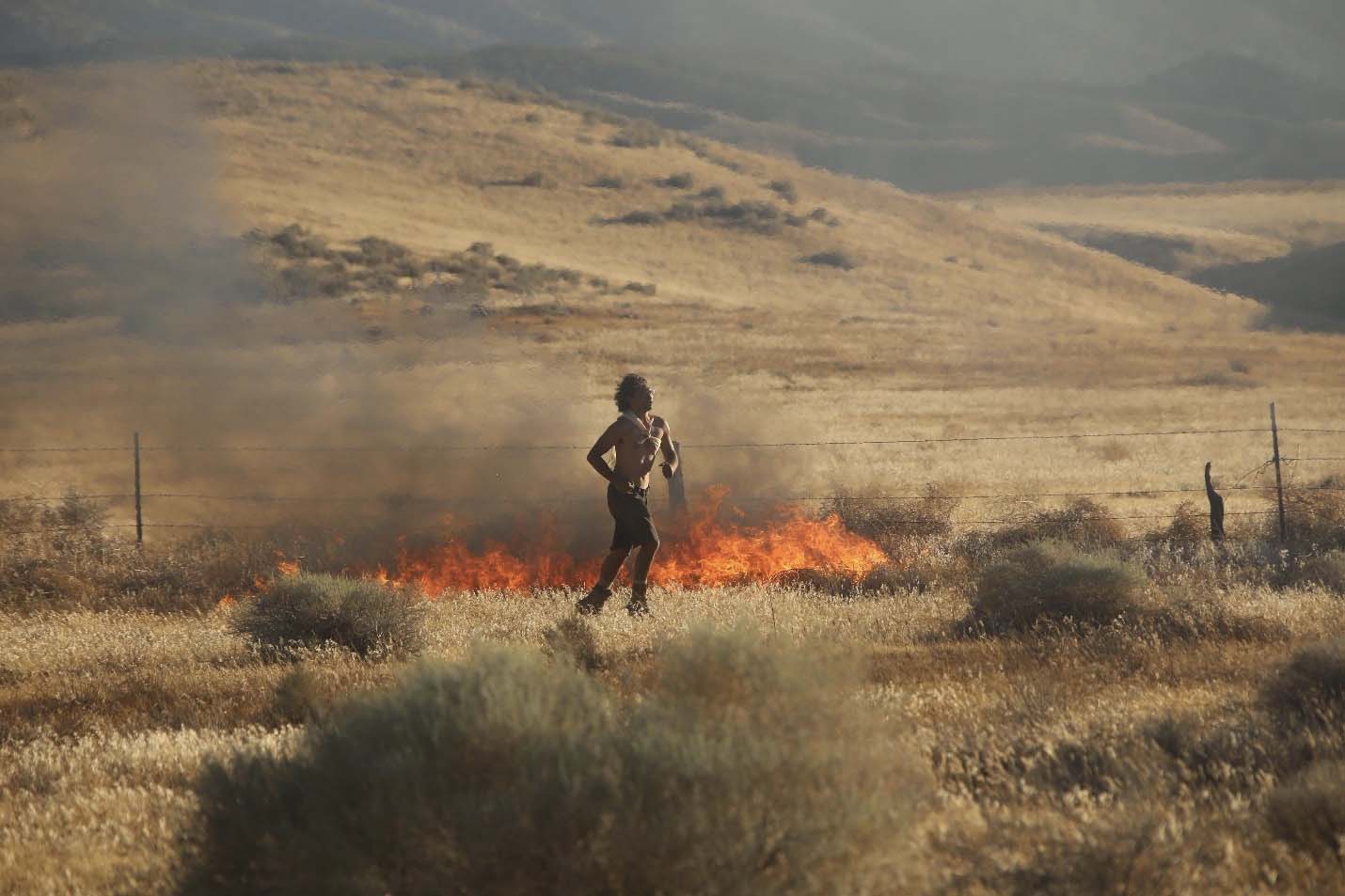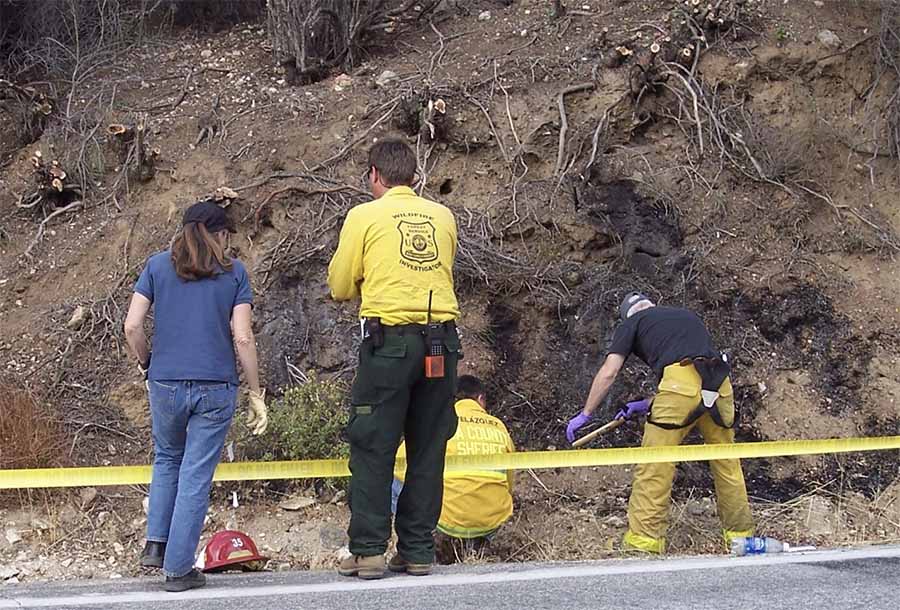
By Joe Konefal and Ed Nordskog
The one criminal who possesses the power of a nuclear weapon at his fingertips is the wildland arsonist. In certain areas of the world, if the weather and fuel conditions are favorable, a wildland arsonist has the instant ability to burn an entire community to the ground, and kill scores of people, their pets, livestock, and the wildlife in the area. All of this carnage for the mere price of a match, a lighter or a road flare.
The good news is that there aren’t that many people intentionally setting arson fires in the wildlands, as yearly statistics prove that the overwhelming number of wildfires are not acts of arson. The less good news is that historically, many of the actual wildland arson cases go “unsolved”. The reasons for this are many, but one important reason is that compared to their urban counterparts, wildland arson investigators working for public agencies get very little money for resources and investigative training. Wildland arson cases have two distinct phases; the scene work, and then the follow-up criminal investigation. Many wildland investigators have a high degree of skill when conducting the “Origin and Cause” investigation at the scene, but they often lack the years of experience and ongoing certified training to pursue the criminal investigation portion of the case. There are currently very few schools, books, or online sources out there dedicated specifically toward conducting an arson investigation in the wildlands.
That’s too bad. Analysis of case histories shows that a significant portion of wildland arsons are committed by a small number of persons…the serial arsonists. The majority of arson series are eventually solved, provided that the arsonist continues setting fires. It is not unusual for investigators to learn that a single serial arsonist in the wildlands had set twenty to one hundred fires (or more) prior to the arrest.
Threat Assessment
Traditionally, the fire service (urban and wildland) rates arson fires by their damage (dollar loss) or their size in acreage. This may greatly affect how much attention, manpower, and resources are devoted to an investigation. But, to an investigator, the size of the fire has very little to do with assessing the threat level of an arsonist, as the size of the fire event is completely out of the hands of the arsonist. The below factors are much more important to consider when conducting any threat assessment during a wildland arson investigation of an unknown subject. These factors are important when considering the intent of the arsonist.
-Large number (more than three) of suspicious or arson fires in an area
-Rapid frequency of suspicious or arson fires in an area
-Arson fires purposely set in extreme fire conditions
-The use of an incendiary device by the arsonist
If any of these four factors are present, then even small fires or failed arson events (all serial arson cases have these) are to be considered high threat. If an investigator determines that an offender is high threat, then the investigator must take immediate steps to approach this investigation as a major case investigation, and employ an arson task force approach to the case.
It is well known among modern criminal investigators that if you dedicate enough resources on any case, you can probably solve it fairly quickly. The real issue is that public agencies seldom have the luxury to focus on any one case until it gets media attention. This causes “small” fires set by arsonists to be classified as a “nuisance”, and put on the back burner for weeks or months until the arsonist sets a much larger or more destructive fire.
Our position is that through training, and a proper threat assessment after every arson event, (small or large), investigators will more quickly focus resources on an emerging problem before the disastrous arson attack takes place.
Arson Task Force Approach and Investigative Mindset

This investigative mindset simply means treating the case as a major case from the beginning and using sufficient resources to solve the problem. A task force can be as few as three to four investigators, or up to hundreds of investigators and support personnel. The key to every task force is simple: Bring the right people to the team, not the most.
An arson task force should be comprised of veteran investigators who have the ability to think and to be flexible. It should be led by a law enforcement trained manager, who works alongside the Lead Arson Investigator. The Origin and Cause experts must be highly trained and certified in their skill, so that they can testify in court at a later date. All other task force officers should be experienced enough to conduct general investigative duties such as interviewing, and leads/canvassing operations.
Specialists to aid the task force should be considered. Specifically, crime analysts, cell phone and computer experts, social media investigators, man-trackers, scent tracking K-9’s, CSI personnel, and experienced profilers are excellent additions to any arson task force.
Sensitive Information
All arson investigations, particularly major cases, are highly sensitive and should be treated with the utmost confidentiality. Only those persons actually on the investigative task force should know the details of the case and any evidence found. FBI and USFS studies of past major wildland cases show that the majority of investigations were plagued with information “leaking” that jeapordized the prosecution of the case. Case sensitive information and photos should never be shared via email, social media, or posted at fire or police stations.
Investigative Steps
Despite past beliefs, arson cases are not “special” and are quite similar to a typical homicide investigation. Done correctly, many of them are solvable . Arson investigators should conduct their investigations by mimicking the methodology used by successful homicide detectives. The following steps are recommended (in roughly this order) for most major criminal investigations, including arson:
-Scene Processing: Origin and Cause, and CSI work for criminal evidence
-Scene photography/video
-Interviews: Responding firefighters, 911 caller, citizen “rescuers”, witnesses, etc
-Evidence Recovery: incendiary device, foot or tire impressions, physical evidence
-Evidence Exploitation: all evidence must get to a crime lab immediately for forensic exploitation
-Use of accelerant K-9s’; and use of Scent Tracking and Mantracking Teams
-Canvassing Operations
-Social Media Investigations
-Crime Analysis to look at historical fires in your area, or adjoining areas
-Plotting fire events on maps and charts (Geo-spatial and Temporal Analysis)
-Pattern Analysis: Experts brought in to analyze the case for patterns and linkage
-Behavior Analysis or Profiler: Useful on serial cases, or for analyzing incendiary devices
-Case building techniques: Linking a suspect or vehicle to the scene via forensics, eyewitnesses, etc; or linking one scene in a series to additional suspicious scenes
-Surveillance Operations
-Search warrants: For the suspect’s home, work, vehicle, cell phone, computer, etc
-Arrest and Interview of suspect
-Court preparation
Incendiary Devices
It is not common to find incendiary devices in any arson event, However, the use of an incendiary device is more common in the wildland setting than any other type of arson (other than extremist arsons). An incendiary device is the single most important piece of evidence in any arson/serial arson case. The device should be treated like gold and should be immediately brought to a crime lab for forensic exploitation and analysis.
Device analysis will tell the investigator volumes about the unknown subject, as the use of incendiary or explosive devices is considered learned behavior. That means that the subject has some past experience or training in building, testing, and deploying devices.
Forensics recovered from an incendiary device can positively link the arsonist to a fire or a series of fires.
Help is Available
There are currently in the wildland arson investigation sector a few places where investigators can hone their skills and receive up-to-date training. The FI-210 Origin and Cause training offered by various entities is mandatory for any wildland investigator, but it is merely the first step. The FI-310 training program has undergone an update and is ready for new classes in the upcoming year. The Nevada chapter of the IAAI currently hosts annual training each February in Reno, Nevada, dedicated to Major Wildland and Serial investigations. The authors urge fire managers to invest early in training your investigators.
About the authors:
Joe Konefal is a retired Supervising Bomb Technician and Arson Investigator for the California Department of Forestry and Fire Protection. He has worked in the arson and bomb world for more than 35 years. He has been the Lead State of California instructor for arson-explosives related topics for two decades.
Ed Nordskog is a retired Arson-Bomb Investigator and Profiler for the Los Angeles (California) Sheriff’s Department. He has been a Detective for most of his 35 year law enforcement career. He is an author of four previous books on arsonists, serial arsonists, and incendiary devices, and is an internationally known expert on these subjects.
Together, both Joe and Ed have worked nearly 3,000 cases in the arson world, including being involved in over 60 serial arson investigations, have a combined 30 years of teaching arson and related subjects to other investigators, and have testified over 150 times as “experts” on these subjects in court.
They are co-authors of the books and Arson Investigation in the Wildlands (available only at arsonwildlandsbook.com) and Fire Death Scene Investigation.

Sadly, these figures are all too true. Whenever I had a spate of “undetermined” and arson fires in my area my first instinct was to take a hard look at my paid-call folks. Then, I’d find out who had been taking Fire Investigation 1 and Fire Investigation 2, in the fire science program at our local junior college, and what was being taught in the class at that time. Usually, the devices I was finding and what was being discussed in class were one in the same. All too often we didn’t have enough fire prevention people to work these incidents so, a heart-to-heart discussion ensued at a company meeting with folks being told, “We know who you are and what you’re doing – knock it off before you ruin your life, do some real damage, and get someone hurt”. it was amazing how that put a quick stop to a potential problem in the making.
And don’t forget that there is a long history of wildfire used as a tool of war, from Native American inter-tribal fighting, to the Japanese firebombing western US during WW 2, to Palestinians setting fire to forests in Israel.
And the potential for terrorists-ignited fires in the US has been addressed in several papers and threat-analysis reports.
Potentially a big problem.
In 1973, I took a course in Fire Control at College of the Redwoods near Fortuna, CA. My instructor was a retired CDF Wildland Arson Investigator. He told us that 80% to 85% of wildland arsonists were firemen, former firemen, wanna be firemen, or disgruntled firemen. During my USFS career and afterwords as an AD WF, I found these statistics to hold true to this day. These have been, and continue to be, verified in law enforcement investigations, news articles, and anecdotes by WFs and FFs.
I’m with you Fred. I also was a WFAI and found some of the usual suspects related to fire in one way or another. I participated with state and county investigators doing interviews and found that the suspects had a very twisted mindset.